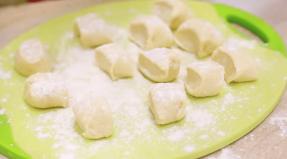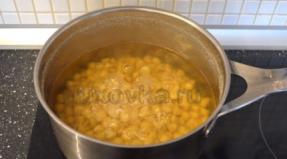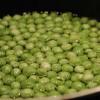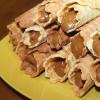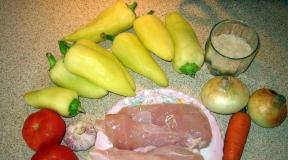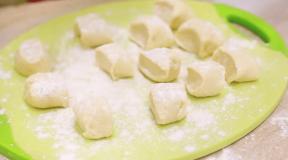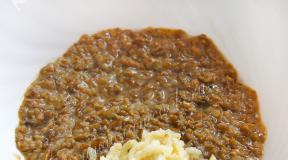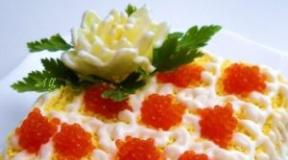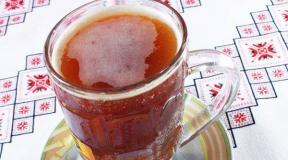Tincture from old jam. Jam tincture Infuse moonshine with jam
A Russian cannot live without jam. Then let the candied jars stand for years on the back shelves of pantries and fill much-needed space in the refrigerator. But still, every autumn an epic begins called “It’s time to cook!” Sugar is bought in bags; all the burners on the stove are tightly occupied with basins and other containers. Banks are sterilized en masse. In general, for several days the kitchen turns into hell - although it doesn’t smell like sulfur, but much better...
But the excitement ends - and the question immediately arises: what to do with last year’s jam? It's a shame to throw it away. That's right, no need to throw it away. After all, last year’s jam is an excellent “raw material” for the production of a wide variety of alcoholic beverages.
Wine
Winemaking is the most masculine occupation. Moreover, making wine from jam does not require much labor: you do not have to fuss with berries or calculate the required amount of water and sugar.
First of all, we must remember that the utensils for preparing wine should be glass, enamel, wood or ceramic, but in no case metal.
Now let's talk about how much water you need to add to the jam. An approximate ratio is that 3 liters of “solution” should contain 1 kilogram of sugar. That is, add about 1.5-2 liters of water to 1 kilogram of jam (depending on how much sugar you used when making the jam). The water must, of course, be boiled.
Mix the jam and water thoroughly and let it sit for a day. Then stir again and leave for another day. Then strain thoroughly and into another container. Now this mixture is called wort...
In order for the wort to ferment, yeast must be added to it. If it is not possible to get wine ones, bakery ones will also do - half a pack per bottle. Dissolve them in warm water with a little sugar - and into the wort. Very important: do not use brewer's yeast under any circumstances!
Primary fermentation takes 8 days. It is violent - the mixture comes straight out of the bottle. Therefore, when adding wine, leave a little free space. And do not close the container during this period.
Secondary fermentation (after the primary fermentation has ended, the wort must be strained and poured into a clean bottle) should take place in a container closed with a water seal. A water seal is a stopper with a tube, the other end of which is lowered into a jar of water. Or the famous “hand of Ho Chi Minh” - a rubber glove placed tightly on the neck of a bottle or jar. Just don’t forget to pierce the fingertips of the glove with a needle...
Secondary fermentation lasts 40 days. And the wine is ready! It remains to be strained and bottled.
A few notes
If the wine lacks acidity (for the curious, if Ph is less than 6), then it turns out, as tasters say, “flat”: something like a compote with alcohol. Low acidity, for example, raspberry and strawberry jam.
Therefore, the wort must be “corrected” before primary fermentation. To do this, just add a glass of blackcurrant juice or half a glass of blackcurrant jam to the bottle with the wort. Blackcurrant jam, naturally, must be prepared like the main wort - diluted and strained.
If you “missed the mark” with water when preparing the wort, it’s okay. Add sugar. But remember: you can’t pour sugar into a bottle - you must first boil the thick syrup, let it cool, and then pour it into a container with juice. And besides, do not take refined sugar - only sand!
With gooseberry jam, for example, the acidity is fine. So when making wine from it, you should think about adding additional sugar: 50-100 g per 2 liters of must. Advice - taste the wort. And assume that approximately half of the sugar will “go” into alcohol during fermentation. By the way, you can add not only sugar, but also honey to the gooseberry jam wort, and the result is a very tasty wine. The proportions are the same.
Tinctures
A sweet tincture can be made from any jam, even the most ancient one.
In fact, according to the scientific definition, sweet liqueurs are prepared “from a blend of alcoholic infusions and fruit and berry juices, sugar syrup, rectified alcohol, citric acid and softened water.” Simply put, factories mix all these ingredients in different proportions to ultimately produce drinks with a strength of 16-25°, which have a sweet and sour taste and aroma of the fruits from which they are prepared. Sugar in a sweet liqueur should be from 8 to 30 grams per 100 milliliters of drink.
Now let's move from theory to specific recipes.
Strawberry jam tincture can be prepared as follows - 50 grams of jam are mixed with 100 grams of alcohol or, at worst, vodka. After keeping this mixture for a couple of hours (but better - a day), pour it into 500 grams of vodka. Add a little vanillin. If you have blueberry juice on hand, you can have that too. Citric acid - to taste. The liqueur should be light red in color with a sweet and sour taste and strawberry aroma.
Another recipe: pour 1.5 cups of alcohol or vodka into 300 grams of jam. Stir well, seal and leave for two days. Then strain and use the resulting infusion as a base - add vodka to it until you feel that you have either a tincture or a liqueur. But don't overdo it with tasting...
Cranberry liqueur is prepared, naturally, from cranberries pureed with sugar. Do as in the previous recipe. If you want it sweeter, add syrup.
Remember: cranberry has 20° strength and 25 grams of sugar per 100 milliliters of finished tincture.
If you dilute it with water to 12°C and add sugar to 30 grams per 100 milliliters, then it will already be a dessert drink “Klyukovka”.
If you add blueberry juice, fresh lemon peel, cloves and vanilla to the infusion, then it will be cranberry punch. It should contain 33.8 grams of sugar per “hundredth” of punch.
Blackcurrant liqueur is very good. It's generally easy to prepare. Pour the same 1.5 cups of alcohol or vodka into 300 grams of jam. Soak all this for a couple of days in a well-sealed vessel, then strain. And dilute to 20° strength. Add syrup up to 30 grams per hundred square meters. Feel free to experiment with what’s in your pantry or refrigerator: mix different types of jam, add herbs, etc. Just watch the strength and sugar.
And one more feature - sweet liqueurs made from jam from your garden are good on their own and do not need improvement. But if you decide - for variety - to make drinks from exotic fruits such as apricots, peaches, quinces, pineapples, kiwis and so on, then feel free to add cloves, cinnamon, vanilla and other “colonial” spices to them.
Liqueurs
It’s strange, but today you can find anything in stores except liqueurs. And this primordial drink has been known for hundreds of years - and has enjoyed success for the same number of years.
Strong, aromatic, liqueur is very easy to make. Moreover, if in the original it is too strong for ladies, then it can be easily converted into “female”. But liqueurs have one drawback - they must sit and “ripen” for sometimes two to three months.
So, first, as usual, a little theory. According to the classic recipe, the berries are poured into bottles and filled with purified strong vodka. By the way, strong vodka is sometimes called a mixture of two parts vodka and one part alcohol. But it’s quite possible to get by with vodka – just not the cheap “basement” kind.
After the berries are filled, the bottle is exposed to the sun. There is no need to seal the container - it will be enough if you tie a thick cloth around the neck.
Rowan liqueur should not be placed in the sun - it needs partial shade. Rowan berries will ripen well on a kitchen shelf or in a closet.
So it’s easy to prepare a classic liqueur. But we decided to make it from old stocks of jam.
The principle is the same as for tinctures: pour 400 grams of jam with 2-3 glasses of vodka. The vodka “fork” makes it possible to create a drink to suit your taste – for men or for women. After the jam has dissolved and the mixture has settled, carefully pour it into beautiful bottles.
There is another recipe - you need to add water to the jam: a glass for 200 grams of jam, and then heat it in the oven to 80°. And keep for about 1 hour. Then pour vodka in the specified proportion.
Improvisations on a theme
When the first experiments show that you have more or less mastered the classic recipes for the production of wines, liqueurs and liqueurs, then the most interesting time comes - the time of alcoholic improvisations.
Each of us has read in the literature about drinks like old-world cherry. How to cook it?
Take 1 kilogram of cherry jam, add water at the rate of 1 liter per 500-700 grams of jam (to taste), place the resulting “porridge” in a bottle. After 3 days, add 500 grams of vodka, 1.5 grams of cinnamon, 1 gram of nutmeg and place in a warm place. After about 8-10 days, the infusion will become transparent. Strain it and serve...
Ukraine is famous not only for vodka with lard and orange-colored political battles - the people there have always been very knowledgeable about the subject of tasty drinks. And besides, they have always been distinguished by, how can I put it... thriftiness, or something... And therefore God himself ordered us to adopt experience in this matter. Fortunately, there are no problems with ingredients today.
We'll start with Ukrainian cherry. This liqueur is best prepared in a barrel, but you can get by with a three or five liter jar.
Take a baking sheet with sides. Fill it with a 2 cm layer of cherry jam. Place the baking tray with the cherries in the oven, which is heated to 60-70°. Keep the cherries there for about an hour - until the jam noticeably thickens. Then cool and transfer to a jar. When the container is full, fill it to the top with vodka and put it in the cold - in a cellar or refrigerator (but not on ice) - for ten days.
After 10 days, drain the liqueur. And pour the remaining berries again with vodka and let them stand for 14 days - in the same conditions, that is, in the cold. Drain the infusion again and repeat the operation again. But the liqueur should sit for 7 weeks. Then mix all three liqueurs together and filter. Then pour the drink into bottles, cork, fill the caps with sealing wax and place in a cool, dark place. Retrieve bottles as needed...
The next drink is a spotykach. Let me note that it lives up to its name. The head is fresh, but the legs are braided...
In order to prepare spotykach, you need to take 1 kilogram of blackcurrant jam, 3.5 glasses of water and 750 grams of vodka. Mix jam with water and cook over low heat for about 1 hour. Remove the mixture from the heat, pour 750 grams of vodka into it, stir well, then put on low heat and, without bringing to a boil, stirring continuously, let the liqueur thicken. After this, cool the potykach, bottle it, seal it and store it in a cool place.
Theoretically, you would also need to infuse 5 grams of cinnamon, 10 grams of nutmeg, 5 grams of cloves, 5 grams of saffron, 20 grams of vanilla for 2 weeks in half a liter of vodka, shaking constantly. Strain the tincture and add to the prepared potykach. But this is absolutely for ardent wine lovers...
Slivyanka is also very respected among the people. It is done as follows. Plum jam is poured into a wide-necked bottle and topped with vodka. The bottle is tightly capped and left for 6 weeks. After this, the mixture is filtered and bottled. The bottles are closed with corks, which, in turn, are filled with paraffin. Store the plum in a cool place. It will be ready only after 6 months of aging.
"Maraschino" and "Black Johanna"
These are not characters from old plays. These are liqueurs. Let's start with "Black Johanna". A liqueur with this name is very easy to make. You need to take 1 kilogram of blackcurrant jam, 2-3 cloves and 1 liter of good vodka. Squeeze the jam, add cloves and pour vodka. Seal the dishes and place them in the sun. Leave for approximately 6 weeks.
After aging, strain through cheesecloth and bottle. The bottles need to be shaken from time to time. In a week, the Black Johanna liqueur is ready...
Maraschino requires more time to prepare. And, to be honest, I have a great desire...
So, prepare 3 liters of raspberry water, 1 liter of cherry water and 1 liter of orange blossom water. Cherry water (and all the others) is prepared at home like this: diluted jam (1 kg of jam per 4 liters of water) is distilled through a distiller. As for orange flowers, which, like the orange tree itself, do not grow in our area, you can easily get by with any flower water, adding a little zest of any citrus fruit. Flower water is made from any flowers of fruit trees - pour the collected apple, cherry, plum flowers (or whatever grows on the site) with boiled water at a one-to-one weight ratio, add one quarter by weight (relative to the mass of the flowers) of the zest of oranges and lemons. Leave for 1-3 hours. And - into the distiller. In principle, you can get by with just an infusion of the zest alone - after all, it’s not spring yet...
When all the waters are ready, they are mixed. This makes 4 liters of mixture. It is diluted with 6 kilograms of sugar and filled with 3-3.5 liters of alcohol. Then the resulting solution is poured into a bottle with a narrow neck. They seal it with special care, in addition filling the cork with sealing wax. And put in a warm place (room temperature) for 6 months.
After settling, the liqueur is poured very carefully so as not to stir up the sediment. By the way, the sediment can be filtered through flannel and drunk. The poured liquor is stored in a cool, dark place in sealed bottles. It can be stored indefinitely, only improving over time.
Let me remind you that only food grade alcohol can be used for liqueurs. The best is luxury or medical class. Extra class alcohol and vodka should be purified with activated carbon: for vodka – 1 matchbox per bottle, for alcohol – 2 boxes. Pour charcoal into a bottle, seal it and keep it for a week or two, shaking it daily.
Ratafia - ladies' vodka
No matter how sweet vodka is, it still remains a man's drink. However, ladies also sometimes want to drink vodka. True, they are embarrassed about it...
Our ancestors were more rational than us in this matter. Is it indecent for a lady to drink vodka? So, we need to invent ladies' vodka. And they invented it.
And so that everything would finally be decent, they called it not vodka, but ratafia. "...What are you drinking?" - “Ratafiy!” And no one will think that the lady is on the sly, out of grief... Or out of joy... Or with her friends...
Almost all ratafias are prepared with alcohol - naturally, food grade, "luxury" or "extra" purification. For simplicity and reliability, try to find medical alcohol through familiar doctors or pharmacists - it is even superior to “luxury” cleaning. But if you get “stressful” with alcohol, then you can take the highest grade vodka. In this case, exclude water from recipes.
So, there are two types of ratafia. Some can be made from jam. Others are made from “materials” that can be bought at a nearby store. The principle, in general, is the same for both - 500 grams of jam per 2.5 liters of vodka. Or 500 grams of jam per 1.5 liters of alcohol - only after infusion you will have to add 1 liter of water.
Pour vodka or alcohol into the jam, mix well and leave in the refrigerator for 3 days. Then repeat the process (mixing and settling) three times. Then filter the resulting drink...
There are different ratafias - Grenoble, Chinese, raspberry, made from almonds and apricots, muscat grapes, peach pits, white and red roses, plums, cherries, quince and so on. A variety of seasonings (except black pepper) are used in their preparation. Ratafias are rich in flavor and very sweet – almost like liqueurs. But it's still vodka.
Color
Drinks can not only be made at home, but also tinted. Let me note right away: all the recipes for the dyes that we will talk about are quite old. And therefore (due to the weak development of chemistry at that time) absolutely safe. Another feature is that some ingredients used to color vodka were freely sold in shops before the revolution. Today it is almost impossible to find them. But, you know, you can’t remove the words from the song...
How to color vodka scarlet and purple?
To do this, finely grind a spool (or, more simply, a tablespoon) of cochineal and cook in a saucepan with a glass of damask (1.23 liters) of water, adding the same spool of purified powdered cream of tartar. Let it settle. Then strain through a cloth. With this solution you can tint vodka in various shades of scarlet, depending on how much you add.
If vodka colored with this solution is infused with flowers of femur or yarrow, it will turn purple.
If you haven’t stocked up on femur or yarrow (don’t forget to do this in the 2009 season), it doesn’t matter. You can tint the purple color with vodka and dried blueberries. But the color of vodka infused with berries will be simply red - and only...
The green color of vodka is obtained by infusing it with black currant leaves, adding the juice of parsley leaves or green onion feathers. With currant leaves everything is simple - the leaves are stuffed into the jar to the top, but not compacted. Then they are filled with vodka or alcohol. You need to squeeze the juice out of the parsley leaves. With green onion feathers it is somewhat more complicated - they must be washed, put in hot water, boiled twice, then, after removing, put in cold water and, squeezing them through a cloth, cook the squeezed out in a stainless steel ladle until the liquid has boiled by half. What remains in the ladle will be the green paint.
The golden-orange dye is obtained by infusing saffron in alcohol, with the addition of a small amount of blueberry or blueberry juice.
If you like yellow colors, infuse vodka with pure saffron. The more you put it in, the more saturated the color will be.
A beautiful blue color can be obtained by infusing vodka or alcohol on cornflower flowers.
Candied old jam is often used to make homemade tincture. Such a product has much less beneficial properties than tinctures with vodka, alcohol or moonshine made from fresh fruits, vegetables or herbs. Drinks made from old jam are more reminiscent of aperitifs than healing agents. They are easy to prepare and go well with a variety of dishes; they will always be appropriate for any holiday table. They can be added to desserts and used in the preparation of various sauces and marinades.
Simple recipes
Quickly navigate to the article
Jam tincture is not the only thing that can be prepared from this product. The principle of its preparation is quite simple. From jam at home, you can make mash for moonshine, liqueur, liqueur.
Advice: it is better to make mash for moonshine from fermented jam at home. The process of ripening a product from such raw materials will occur very intensively. For 1 kilogram of jam, it is enough to take 250 grams of alcoholic yeast, 1.5-2 kg of sugar and 10 liters of water.
Jam tinctures are prepared at home without adding sugar. It is contained in sufficient quantities in the jam itself. The cooking recipe includes:
– 0.5 kg of jam;
– 0.5 l of vodka.
Advice: if homemade tincture with jam is prepared with alcohol, then it is better to dilute it before using it with bottled water in a 1:1 ratio.
The products are mixed in a glass jar that has been washed and removed from foreign odors. The prepared mixture is covered with a lid and sent to infuse in a dark room at room temperature. You can determine the readiness of a vodka tincture by the color of the drink. It should be rich. During the infusion process, the product must be shaken periodically at least once a day.
Read also: Preparing a healthy ginger tincture
How to improve the taste of the drink?
You can make the vodka jam tincture more aromatic and interesting by adding additional
Homemade jam tincture
Ingredients. Universal components for improving taste, which are difficult to spoil the taste of any alcoholic drink containing sugar, are citric acid, cinnamon and vanilla. Depending on the type of jam, currant, cherry or strawberry leaves can be used to prepare the drink to enhance the taste.
Finely chopped straw is sometimes added to quince tincture made from jam made with vodka or alcohol. It gives the drink a spicy flavor. Chokeberry and honey go well with quince. Lemon or orange peels can be excellent flavor enhancers for drinks made with jam from strawberries, wild strawberries, and rose petals. Dogwood tincture will be improved by vanilla, and plum and apricot tincture by dried apricots.
Pouring the finished product
At the end of the infusion process, the tincture must be cleared of sediment. For this purpose it is used  ordinary funnel. Several layers of gauze and cotton wool are placed in it. The product filtered in this way is sent to settle for several days, after which it is filtered again.
ordinary funnel. Several layers of gauze and cotton wool are placed in it. The product filtered in this way is sent to settle for several days, after which it is filtered again.
Tip: Carbon filters should not be used to clean drinks. They give the product an unpleasant aftertaste and can cause the drink to change color.
The process must be repeated if the drink is not cleared to complete clarity. The finished product is bottled, corked and sent for storage. For this, a cool room is selected. You can also store the tincture in the refrigerator.
When making supplies for the winter, most housewives close. It is possible that more sweets were closed than necessary. Either the housewife tried to process all the berries, or she simply did not calculate the required number of preparations. Something needs to be done with the resulting surplus. As an option, you can make wine (see how to do this in more detail) or a delicious homemade liqueur.
The article discusses two options for preparing liqueur: from good jam, which is simply not available, and from fermented jam, suitable for beneficial use.
Recipe for jam liqueur with vodka
To prepare a tincture that will appeal to women, confiture made from cherries, currants, raspberries or strawberries is suitable.
In addition to a half-liter jar of jam, you need to prepare half a glass of sugar and a glass of water. The amount of vodka that should also be prepared may vary, and the strength of the liqueur will depend on this. For a half-liter jar, half a liter of vodka is enough, but you can take a liter or even one and a half.
First of all, prepare syrup from sugar and water. The jam is added when the sugar has dissolved and the syrup is boiling. Everything mixes well. The resulting mixture should be brought to a boil and boiled for about five minutes, stirring constantly and skimming off the foam.
Now you need to remove the base, and without waiting for it to thicken, strain through cheesecloth. The liquid obtained after filtering must cool completely. If you pour vodka into uncooled syrup, the alcohols will evaporate, and you will get not a liqueur, but a bitter compote. Feel free to pour vodka into the cooled syrup. All that remains is to bottle it.
You can start drinking the liqueur immediately after preparing it, but a more pleasant taste will appear after about 10 days.
A simple recipe for fermented jam liqueur
You shouldn’t part with fermented jam either. It will make an excellent strong liqueur, with the taste of berries. The recipe is so simple that any beginner can handle it.
In addition to a half-liter jar of fermented jam and one liter of vodka, you will need a three-liter jar and a thick rubber glove.
You need to pour jam and vodka into a three-liter jar. Stir and place a rubber glove on the neck of the jar. Now the resulting mixture will ferment for 7-10 days. The fermentation period can be easily tracked using a rubber glove. At first, the glove will gradually rise from the fermentation vapors. During the period of intense fermentation, stand for several days. Then it will begin to descend, and eventually hang limply on the bank. When fermentation is complete, the liqueur needs to be strained and bottled.
Serve yourself with compote or confiture of aromatic summer berries, fruits and vegetables. But, unfortunately, not all of them are used up evenly, and often jars stagnate on owners’ shelves for several years. Homemade jam liqueur is one of the options for turning stale raw materials into a sought-after product. It can be made with alcohol, vodka, cognac and even moonshine.
Advice: if homemade alcohol is used as an alcohol solvent, then for infusion it is better to take varieties of jam with a pronounced taste.
What and how best to cook from
Quickly navigate to the article
There are several basic rules for making a really tasty liqueur from jam at home:
- It is better to dilute the candied product with water and digest it.
- It makes sense to reject cans with mold, but if economy prevails, then we remove the mold (plus 1–2 cm of unspoiled product), and digest the valuable cheese.
- To make the filling faster with thick jam, after adding alcohol, it should be heated in a water bath. Temperature is about +70°C, heat exposure time is 30 minutes, the procedure is repeated regularly - 4 times a day for a week.
In general, liqueurs made from vodka jam are classified as early ripening. However, if the raw material is a very old, candied, cloudy product, it is better to digest it, if necessary, dilute it with water and cook it using heating in a water bath.
Advice: it is better to prepare mash from old jam in the home kitchen, and then distill it into moonshine. This way you can 100% get rid of possible anaerobic bacteria (including those that cause botulism). In addition, liqueur made from poor raw materials almost always has an unpleasant aftertaste.
The best varieties of jam that make a tasty and healthy liqueur:
- cherry;
- raspberries;
- black plum;
- melon;
- strawberry;
- blueberry;
- black currant.
Read also: Slavic viburnum liqueur with vodka
You can make delicious versions even from vegetable jam, because it’s no secret that many people have several “experimental” varieties collecting dust in their cellars that the family did not like. The following types can be used:
- zucchini with the addition of an acidic component (mint, lemon juice, zest, etc.);
- pumpkin (you can add quince);
- tomato (it is also advisable to acidify).
You can safely add nut membranes, whole nuts, peeled and unpeeled - hazelnuts, pine nuts, walnuts - to almost any liqueur. Don't forget also about spices - anise, star anise, cinnamon, cardamom.
Technology
A delicious homemade liqueur made from both fresh and fermented jam is recommended  cook in the following way:
cook in the following way:
- Take 100 grams of sugar per 100 ml of water and make syrup.
- Add it to 400 ml of jam.
- Bring to a boil and simmer everything together over low heat for 15–30 minutes.
- Cool to at least +20°C.
- Add 1 liter of vodka.
- Let it sit for at least 7 days, shaking the drink regularly.
- Drain the liqueur from the sediment and leave to settle.
- If the sediment appears again, drain it or, if desired, leave everything as is.
- Pour into a storage container and let it sit in a dark, cool place for several weeks.
Important: the liqueur must be poured right up to the cap and the container must be tightly sealed so that aerobic processes do not occur inside the bottle.
Recipes

- liquid jam (cherry, strawberry, raspberry) - 400 ml;
- alcohol with a strength of about 40° - 1 liter.
Mix jam and alcohol, shake 2-3 times a day and leave for a week. Then drain the remainder and pour into a container for storage. The liqueur will have a strength of just over 28°; if the raw materials are of high quality, then it will be easier to drink than wine. So be careful, and most importantly, protect the ladies from such a tasty but insidious drink!
Many housewives are familiar with the situation when the jam has not yet spoiled, but it has been standing in the pantry for many years and it seems that it should not be eaten, and the taste is not the same. And it’s even more difficult if the jam has fermented. This usually causes regret, because a lot of food, money, and effort were spent to prepare it. A recipe for wine from fermented jam will come to the rescue. With a little more effort, you can get an excellent dessert wine, and the cost of the jam will more than pay off.
A little about the components of homemade wine
To make wine from fermented jam, you don't need many ingredients. This is primarily jam that has fermented or just old jam.
You should take jam from one type of berry or fruit, so you will get a rich, bright taste. If you use several types of product, then combine sour and sweet berries, for example: raspberries and currants, in this case they complement each other.
Instead of yeast, they use raisins, since yeast with fermented jam is more likely to produce mash. If the recipe contains yeast, then wine yeast should be used. They are difficult to find in stores, but they are sold.
For wine you will also need water; it must be boiled. In all recipes, the water temperature is 25–35 C. And in some recipes they use a little sugar, with its help they regulate the sweetness of the drink and alcohol or vodka for strength.
Fermented jam makes an excellent dessert wine with a strength of 10 to 14 O.
About tools and containers
To make homemade wine from fermented jam, you will need glass containers. It would be better to take 5-liter jars, but regular 3-liter jars will do. They are filled no more than 4/5, ideally this is 2/3 of the container (space is necessary for fermentation).
You also need a special water seal; it will require a plastic lid and a needle with a dropper tube and a container of water. The needle is stuck into the lid, and the end of the tube is lowered into the water. This complex device is called a hydrolyzer. If this is too difficult, just buy a rubber medical glove. The device will be required in order to prevent the flow of oxygen into the container with the wort.
You will also need gauze, a colander, clean bottles with cork stoppers and a medium-diameter tube.
All cans and bottles must not only be washed, but sterilized - this will allow you to get a pure taste without impurities and the original aroma of the drink.
Most of the recipes described here are for two 3-liter jars.
What not to do
Before making wine from fermented jam, consider a few important rules:
- You should not take jam with mold; in addition to the fact that this product will spoil the taste of the wine, it is also very harmful to health (you can simply get poisoned).
- If a recipe contains yeast, it is assumed to be wine yeast.
- Raisins are needed for fermentation. You should not wash the berries; wine bacteria live on them, which will allow your composition to ferment. You can take any variety.
Recipe without yeast
To prepare wine this way, be patient. Your product will be ready in 4 – 4.5 months. But the result is worth such a long wait.
For it you need:
- 1 liter of water;
- 1 kg jam;
- 100 g raisins;
- 0.5 kg sugar.
First we will make the wort. We take water, after boiling it and cooling it, add sugar to it. Mix everything well.
Now pour the syrup into the prepared glass container and add jam and raisins to it.
 We put a rubber glove on top of the jar
We put a rubber glove on top of the jar Mix everything, cover with a nylon lid and place in a dark place for 10 days. The temperature in the room should be from 18 to 25 C.
Then mix everything again and strain the liquid into a new sterile container.
Now we put a rubber glove on top of the jar - make a hole in it with a needle and leave it in the same place for a month and a half. First, the glove will inflate, and at the end it will fall off - this is a signal that the wine is ready. During this time, bubbles will appear on the surface of the wine, then their number will decrease significantly.
Now take the tube and carefully pour the liquid into clean bottles. This must be done so that the sediment remains in the jar and does not get into the bottles.
We tightly cover each bottle with a cork and put it in a cool place for another 3 months (not higher than +16). Winemakers call this procedure “aging” and it is necessary for the formation of taste and aroma.
Now you can taste the wine.
A quick recipe for homemade wine from fermented jam without yeast
This wine is good to make from raspberries or other sweet berries. Although it is faster to cook than in the previous recipe, it will still take at least 2-3 months.
To make jam wine at home you will need:
- 1.5 kg raspberry jam;
- 1.5 liters of water;
- 25 g raisins;
- 150 g sugar.
- Place the jam in a sterilized glass container, add water and half the sugar, and then stir everything well. Now add raisins to the contents and close the container with a seal (hydrolyzer or glove).
- We put our mixture in a dark and warm place. The duration of the process will depend on how warm the room is, but will take at least 3 weeks. During this period, the number of bubbles will decrease significantly and the glove will fall off.
- Then, using gauze folded in several layers and a colander, the liquid contents are separated from the pulp. Add the remaining sugar to the liquid and, if necessary, strengthen it with vodka. Mix everything well.
- Next, the liquid is poured into sterile bottles and sealed tightly.
- Keep in a cool place for at least 2 months, and then you can serve.
Recipe with yeast
If you need to make homemade wine quickly, you can use a recipe with yeast and rice. To prepare the drink it will take from 15 days to 1 month. For it you will need:
- 1 kg jam;
- 1 liter of water;
- 150 g rice (glass);
- 20 g wine yeast (fresh).
This recipe makes wine much faster.

- Pour boiled, cooled water into a sterile container, add jam, rice and yeast. Instead of rice, you can take millet, but the result will be somewhat different; rice is still preferable.
- Mix everything thoroughly and cover with a rubber glove with a hole.
- Place the container in a dark place where the temperature is between 18–25 C.
- We monitor the process, when a sediment forms, drain the liquid, leaving the sediment in the jar.
- We pour the resulting semi-finished product into bottles, cork them and place them (necessarily horizontally) in the refrigerator. Let it cool for 3-4 days.
- After this, the drink is considered ready for consumption.
Gourmet recipe
This recipe requires a lot of care and time, but it's worth it.
For it they use:
- 1.5 liters of water;
- 1 cup of sugar;
- 1.5 l jam
- 1 tbsp. l. (with top) raisins.
For preparation you will need a large container of 5 liters. Fill it only 2/3 full and no more.
First we make the wort: Add sugar and jam to boiled and cooled water, taste it, it should be sweet (but not too sweet, not cloying). If the sweetness is not enough, add some sugar.
Now we prepare a seal from cotton wool and gauze. To do this, put a layer (0.5 cm) of cotton wool in 2 layers of gauze and wrap it around the neck of the jar. Experts say that this way the taste will be special. If this is difficult, put on a rubber glove with a small hole.
We place the resulting composition in a dark and warm place; if it is not possible to put it in a dark place, you can cover the jar with a cloth.
Then on day 4-5 add sugar to the container. To do this, use a straw to suck out ½ cup of liquid from our container and dilute ½ cup of sugar in it. And then we return the liquid to the jar through a straw.
This procedure for adding sugar must be repeated again (again for 4–5 days). And then leave the container for fermentation for 1.5–2 months. The duration of the process depends on the room temperature.
If the fermentation process (the release of bubbles) does not stop after 2 months, you will need to pour the clear liquid into another prepared container and close it again with a shutter.
When fermentation stops, the liquid is filtered through cheesecloth and sugar and vodka are added (or not) to taste.
Then the resulting liquid is poured into the container to the top for aging. This process takes from 2 to 6 months (room temperature from 6 to 12 C). First, every 15 days the liquid is poured into another container to avoid sediment (it is left in the old container). After 2 months, this procedure can be done once a month, and then less often (as sediment appears). When the aging is complete, the wine is bottled and tightly sealed.
Store in the basement for up to 3 years.
In order for the homemade wine you prepare to be tasty and retain its taste for a long time, you should adhere to a number of rules:
- Store wine in dark glass containers, preferably bottles.
- The optimal temperature for storage is 10–12 C and without lighting, direct sunlight is completely excluded.
- The bottles are closed with cork stoppers and stored horizontally. This way the cork will not dry out and air will not get into the bottle.
- In the room with wine, a stable temperature should be maintained; temperature changes are unacceptable. Bottles should not be moved; it is better not to move them at all, and especially not to store them in a room where there is vibration.
Read also...
- Homemade recipes for cooking chicken legs in a slow cooker Chicken drumstick gravy in a slow cooker
- Boletus mushrooms for the winter: methods and recipes for preparations
- How to cook cutlets in tomato sauce in a frying pan and in the oven Minced cutlets recipe in tomato sauce
- Stuffed peppers in the oven in halves
